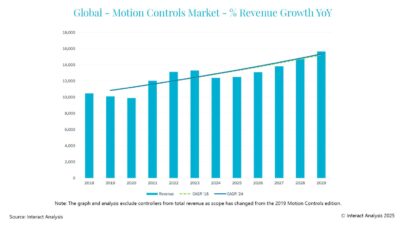KEY WORDS Motors, drives, & motion control AC variable-speed drives AC induction motors Energy-efficiency Just glance at some recent headlines about energy costs and power shortages. Never has it been more timely to implement prudent use—not repressive use—of electric energy. Electric motors in general, and industry's "workhorse" ac induction motors in particular, represent g...
KEY WORDS
Motors, drives, & motion control
AC variable-speed drives
AC induction motors
Energy-efficiency
Just glance at some recent headlines about energy costs and power shortages. Never has it been more timely to implement prudent use-not repressive use-of electric energy.
Electric motors in general, and industry’s ‘workhorse’ ac induction motors in particular, represent great potential and realizable energy savings. Electric motors account for more than 60% of the overall electricity consumption by U.S. industry. For other parts of the world and specific industries, the percentage is still higher.
Of course, energy efficiency applies to all elements of a system or process. For example, use of adjustable-speed drives has grown slowly but steadily, bringing dramatic energy savings to applications where variable motor speed is required. But that’s another story.
Management of the motor over its life cycle is also an issue (see later in article).
Many industrial applications run at constant speed and for prolonged periods. This is where motor efficiency can be practical. A point of perspective is that less than 3% of a motor’s life-cycle costs represents purchase price and installation costs-the rest goes to electricity charges. So far, the efficiency focus has been on larger induction motors (M1 hp/0.75 kW), because of the number of motors and operating hours involved.
A different breed
Better design and material content differentiate energy-efficient motors from earlier standard models. Quality of manufacturing, such as narrower air gaps between the rotor and stator, also comes into play.
Power losses are inherent in any energy conversion process. More efficient motors reduce losses and have longer lives (see ‘How to…’ sidebar). Efficient design often leads to less temperature rise, which reduces motor maintenance. For example, bearing lubrication and motor insulation lasts longer at lower temperatures. ‘Generally, motor life doubles for each 10 °C reduction in operating temperature,’ according to Rockwell Automation Power Systems (Greenville, S.C.).
A cooler running motor is not always assured. Marv Thomas, product manager, NEMA Frame Motors at Siemens Energy & Automation (Little Rock, Ark.) points out a paradox. Lower total losses in an energy-efficient, fan-cooled motor often permit downsizing of the fan to cut windage losses and fan noise (significant in some applications). But as a result of less ventilation, an energy-efficient motor may not run cooler than a standard-efficiency motor of the same size.
Mr. Thomas verifies the substantial mechanical design needed to raise energy-efficiency of an induction motor. He cites use of more and thinner stator/rotor laminations made of higher grades of steel as important, along with ‘physically more copper’ in the motor windings. He puts the typical added cost of higher efficiency motors in the 17-30% range. Premiums decrease with larger motor sizes.
Life-cycle, total cost views
Baldor Electric Co. (Fort Smith, Ark.) looks at energy-efficiency issues of cost and motor management from the full life-cycle viewpoint. ‘Electricity costs account for nearly 98 percent of the lifetime cost of an electric motor,’ according to the company. ‘Efficiency is critical to long-term economical operation. Modest efficiency improvements yield substantial energy savings.’
Most motor manufacturers have more than one energy-efficient product line. Baldor’s top-of-the-line Premium Efficiency Super-E motor (see lead graphic) has a 1-500 hp size range in the general-purpose version. Efficiency ratings have been raised recently for some 125 models of this line, reaching over 96% at 200 hp and above. The Standard-E line meets efficiency requirements of the EPAct legislation (see below).
At Rockwell Automation Power Systems, ‘total cost of ownership’ for the customer has been a long-standing approach to market energy efficiency. This includes various initiatives to show how energy can be saved and costs associated with power usage reduced. ‘Most customers look for a one-year payback and seek information on which to make a good, sound decision,’ explains Thad Roberts, general products manager, Large AC Motors, at Greenville.
Mr. Roberts mentions an ‘Energy Efficiency Calculator’ tool that can aid the decision process. Available from Rockwell Automation, the software tool calculates comparative motor efficiencies and power savings based on application inputs-prior to the purchase of a motor.
All motor manufacturers include some form of analysis tool to evaluate potential energy savings. Baldor Electric offers its Save Plus software that compares operating costs, shows annual savings, and calculates payback time for specific applications. GE Industrial Systems (Fort, Wayne, Ind.) provides an energy cost calculator for ‘electrical machines.’ Most tools are available online.
EPAct took the lead
Major manufacturers have supplied energy-efficient ac induction motors for a long time. Enlightened users applied these ‘premium’ motors in industries and plants where life- cycle costs justified the higher initial price. However, this left a tremendous number of standard induction motors to consume increasingly precious extra power.
The U.S. has taken the lead to put energy efficiency into legislation as part of wider energy conservation issues. Enacted in 1992, the Energy Policy and Conservation Act (EPAct) finally became effective in October 1997. The U.S. Department of Energy (DOE) enforces the rules of EPAct. Scope of the legislation is limited, but it targets the most numerous motor sizes and types used in industry. EPAct was a groundbreaking regulation for a basic level of motor efficiency.
In essence, EPAct covers NEMA design A and B, three-phase, integral horsepower, general-purpose ODP (open, drip-proof) and TEFC (totally enclosed, fan-cooled) motors with 1,200, 1,800, and 3,600 rpm base speeds in the 1-200 hp size range. IEC equivalent NEMA frame sizes and standard kW power ratings are included because EPAct rules apply to motors imported to North America.
EPAct stipulates allowable nominal full-load efficiency for these motors. Nominal efficiency is the average efficiency of a population of motors identical in design and manufacture. Similar legislation is contained in Canada’s NRCan (Natural Resources Canada) and Mexico’s NOM 74 regulations.
An additional line of energy-efficient motors had to be created by most manufacturers to satisfy minimum EPAct requirements. Of course, government regulation of any business activity or equipment sourcing brings its share of negative user response. Still, EPAct is a step forward.
For further reading on EPAct and energy-efficient motors, see CE , Sept. ’97, pp 147-148; and July ’98, pp 91-99.
This original composite diagram compares efficiency initiatives forac induction motors. For clarity, only the case of 4-pole inductionmotors (1800 rpm/60 Hz or 1,500 rpm/50 Hz) is illustrated. Seeapplicable sources for specific efficiency values.
European agreement
European initiatives to reduce energy consumption in electric machines followed shortly after EPAct’s (Oct. ’07) effective date. An agreement between the European Commission and CEMEP (European Committee of Manufacturers of Electrical Machines and Power Electronics) has led to an efficiency classification of induction motors rated at 1.1-90 kW for 400 V, 50 Hz S1 duty-class operation.
Applicable motors are divided into three classes or efficiency zones-Eff1 (high-efficiency), Eff2 (improved-efficiency), and Eff3 (standard motors)-see diagram. ‘The appropriate label on the motor rating plate and in the documentation now makes motor selection easier,’ according to sources at Siemens Automation & Drives (A & D) Group (Erlangen, Germany).
Unlike EPAct, this efficiency labeling agreement for motors sold in Europe started on a voluntary basis in late 1998, but may become mandatory at a later time. As of the end of 2000, it applies to 2- and 4-pole motors, with efficiency levels based on IEC 34-1 and 34-2 standards. The original Control Engineering diagram shows the European motor efficiency agreement as a composite with other initiatives mentioned. The three efficiency zones represent another difference from EPAct’s minimum values.
Siemens A & D recently upgraded its entire line of motors to Eff1 or Eff2 status-the two highest efficiency classes. Other European manufacturers are embracing the efficiency agreement as well.
‘Thanks to optimized material use and innovative technology, we were able to reduce the power loss of our motors by as much as 45%,’ says Werner Vogt, head of Siemens A & D Group’s Standard Drives Division. He explains that Eff1 energy-saving motors can amortize the higher purchase price ‘within a short time’ by lower operating costs-starting at around 2,000 hours per year running time for the machine.
After EPAct
Post-EPAct results have been a pleasant surprise at Baldor Electric. ‘Sales of premium-efficiency motors have not tailed-off,’ says Jerry Peerbolte, Baldor’s vice president of marketing. ‘EPAct legislation helped raise customer awareness of energy-efficiency issues. Our ‘Super-E’ motor sales have grown faster than expected within the overall business.’
Mr. Peerbolte further notes that in the three-plus years since the effective date of EPAct (Oct. 1997), implementing the legislation has been ‘smooth’ for Baldor. ‘Our customers have understood the requirements and benefits quite well,’ he adds.
Rockwell Automation’s Mr. Thomas views EPAct in a positive light for his company, but would like to see its scope expanded. ‘Most users see the basic objective of the legislation and its long-term payback,’ he says. ‘However, some people feel they don’t fit the picture.’ Users with applications where motors slowly accumulate operating hours would be one example.
For Siemens E & A, ‘User acceptance has gone well overall. Some were proactive prior to EPAct’s effective date. Some were upset by the higher motor price tag,’ says Mr. Thomas. ‘But people have survived. EPAct is a fact of life, so let’s move on.’
Other initiatives
Consortium for Energy Efficiency Inc. (CEE, Boston, Mass.) is active in various energy-saving initiatives. CEE started its Motor Systems Initiative in December 1999 to look at efficiency of the entire motor system, such as pumps, fans, and blowers. A later subset campaign called ‘Motor Decisions Matter’ began in August 2000 to emphasize the need for better management of motors during their operating life-including when to repair or replace motors, which become key decisions for users. The National Electrical Manufacturers Association (NEMA) and the U.S. DOE are among organizations that support the campaign.
‘The goal of [Motor Decisions Matter] is to help customers use life-cycle costing methods to determine whether motors should be repaired or replaced before they fail, and when to install energy-efficient motors,’ says CEE.
A still newer initiative, ‘Premium Energy Efficiency Motor Program,’ was announced by NEMA (Rosslyn, Va.) in October (see Oct. 18, 2000 Daily News at www.controleng.com). ‘This voluntary program seeks to widen the scope and range of EPAct,’ states Robert Boteler, executive board member of NEMA’s Motor and Generator (MG) Section. ‘The intent is to create brand recognition through a visible label placed on products from the cooperating member companies and co-signers,’ adds Mr. Boteler.
The trademarked ‘NEMA Premium’ program pushes the efficiency envelope above the nominal values of EPAct (see diagram). It encompasses motors up to 500 hp at up to 600 V supply, and adds definite-purpose, special-purpose, and medium-voltage motor types to the coverage.
Premium labeling
Electric motor manufacturers can sign a voluntary partnership agreement to join the program. (Non-NEMA manufacturers pay a fee.) ‘Only partnering manufacturers may use the NEMA Premium label….for products that meet or exceed the NEMA Premium motor efficiency guidelines,’ states NEMA policy. Customers benefit from lower energy costs and improved system reliability through ability to identify and apply motors labeled for higher efficiency.
Dale Basso, product manager, Medium AC Motors at Rockwell Automation Power Systems and executive board member of NEMA’s MG Section, says the proposed ‘premium motor’ program has been approved by the board and reached final-draft status in April 2001. ‘The program will lessen confusion in the marketplace and fill some holes left in EPAct, such as footless and vertical motors,’ adds Mr. Basso.
Mr. Boteler also wears the hat of director of marketing services at Emerson Electric Co. (St. Louis, Mo.). He refers to the past 10 years in the energy-efficient motor arena as ‘exciting times’ at Emerson, where life-cycle costing has likewise helped promote energy efficiency. Emerson product offerings under the U.S. Electrical Motors brand name include the energy efficient World Motor and premium efficient Unimount lines.
WEG Electric Motors Corp. (Suwanee, Ga.; Jaraguá do Sul, Brazil) recently announced the upgrading of its TOP Premium Efficiency motor line. These totally enclosed, fan-cooled motors meet the ratings of NEMA’s premium motor labeling campaign. Available sizes are 1 to 500 hp.
Higher efficiency electric motors hold the promise for upgrading less efficient units, but require careful economic calculation to justify the extra up-front costs over a reasonable payback period.
Full attention to motor management over the life cycle is also part of the evaluation process. Energy-efficient motors have special appeal to new plants and installations-or as replacements for failed units.
Higher efficiency electric motors are headed for greater recognition. They are an integral part of the solution in the present era of soaring energy costs and supply uncertainties.
For more suppliers, go to www.controleng.com/buyersguide ; for more info, use the following circle numbers, or go on line at www.controleng.com/freeinfo : ABB Motors www.abb.com/motors&drives 224
Baldor Electric www.baldor.com 225
Consortium for Energy Efficiency www.ceeformt.org 226
Emerson Electric www.usmotors.com 227
GE Industrial Systems www.geindustrial.com 228
NEMA www.nema.org 229
Rockwell Automation www.rockwellautomation.com 230
Siemens E&A www.sea.siemens.com 231
WEG Electric www.wegelectric.com 232
How to make ’em efficient
The concept is simple: Increase the motor’s power output to input ratio, or stated another way, reduce the loss, which is the difference between power input and output. However, design details and testing to verify efficiency results are far from simple. Motor losses are defined as no-load losses that remain largely independent of loading and load-dependent losses that change with motor operation.
No-load losses have two subcategories:
Friction and windage loss comes from bearing friction and air resistance of the spinning fan/rotor. Improved bearing and seal selection, plus up-to-date air flow and fan design will reduce this loss.
Core loss results from a combination of hysteresis and eddy current effects due to the changing magnetic fields in the motor’s steel core. Better quality steel and more, thinner gauge laminations can reduce core loss by lowering core flux density.
Load-dependent losses have three parts:
Stator I
Rotor I
Stray-load losses arise from harmonics and circulating currents. Optimizing slot geometry is one way to cut these losses. Manufacturing process variations can also add to stray losses, requiring tight control of all production phases.
Implementing efficiency improvements is not free. Energy-efficient motors can command a 15-30% price premium.
At-load and no-load losses make up roughly 2/3 and 1/3 of the total losses, respectively. Percentages vary somewhat, depending on the manufacturer and motor. ABB Motors (Vaasa, Finland) notes a 72-28% split between load/no-load losses for its typical ac induction motor, while GE Industrial Systems (Fort Wayne, Ind.) puts these loss categories on a 70-30% basis.



